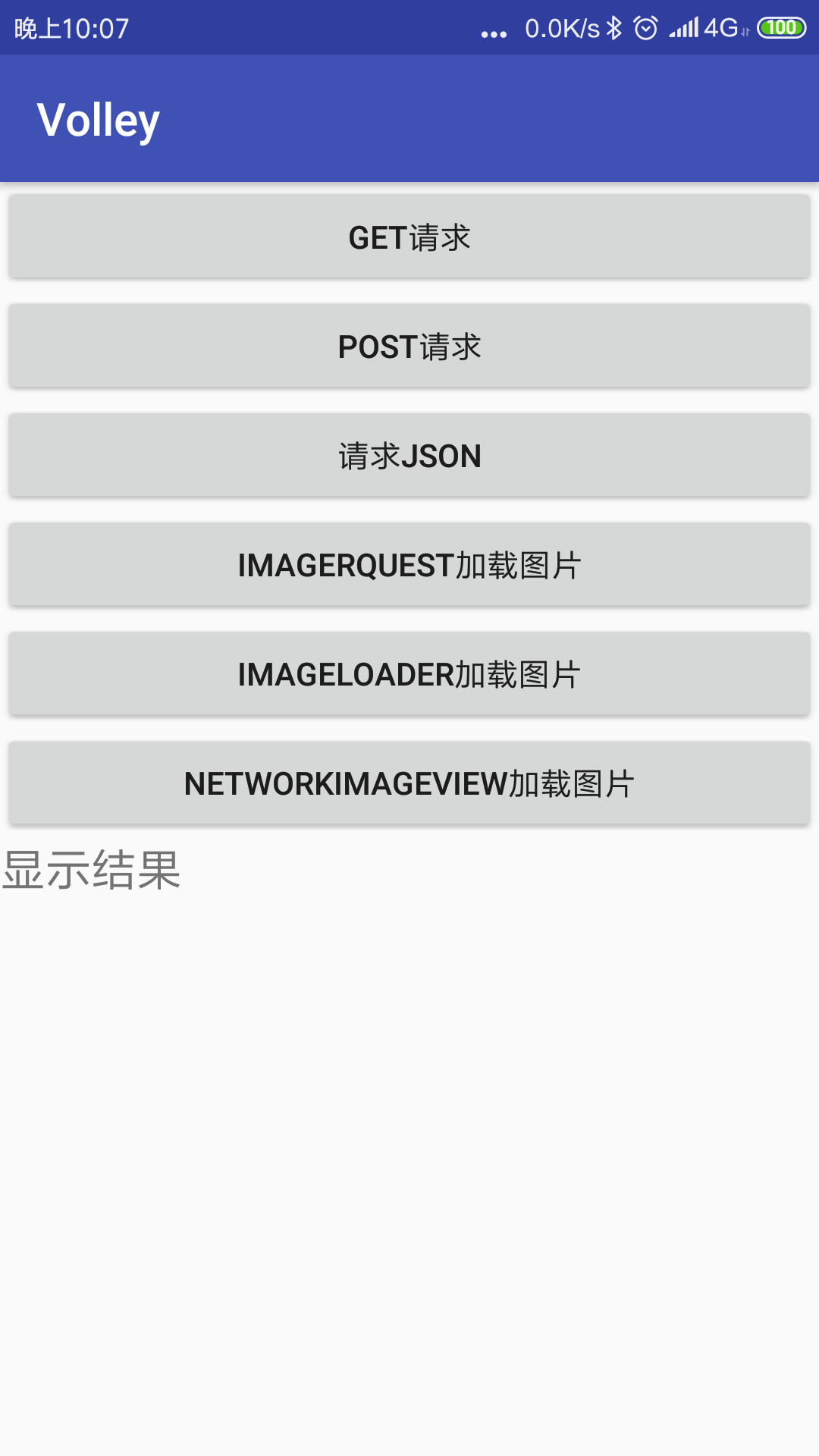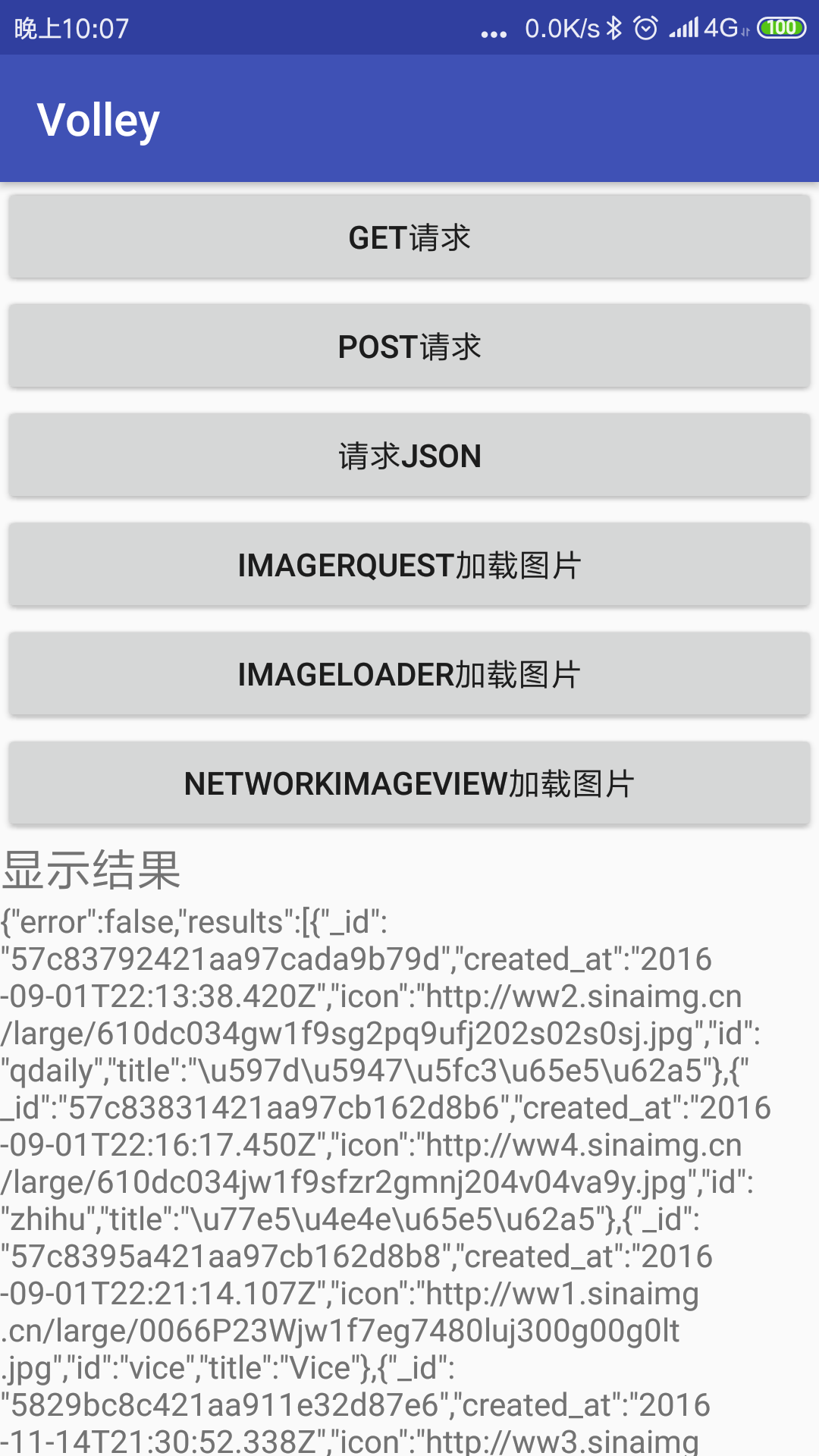Android框架Volley使用:Get请求实现
首先我们在项目中导入这个框架:
implementation 'com.mcxiaoke.volley:library:1.0.19'
在AndroidManifest文件当中添加网络权限:
<uses-permission android:name="android.permission.INTERNET"/>
下面是我们的首页布局:
在这个布局当中我们将Volley框架的所有功能都做成了一个按钮,按下按钮之后就会在“显示结果”下面显示结果,显示结果下面使用了一个ScrollView,并在ScrollView下面嵌套了一个Textview和Imageview,用于把我们加载成功之后的图片和文字进行显示。

下面是首页布局的代码:
<?xml version="1.0" encoding="utf-8"?>
<LinearLayout xmlns:android="http://schemas.android.com/apk/res/android"
xmlns:app="http://schemas.android.com/apk/res-auto"
xmlns:tools="http://schemas.android.com/tools"
android:layout_width="match_parent"
android:layout_height="match_parent"
android:orientation="vertical"
tools:context=".MainActivity">
<Button
android:id="@+id/get"
android:layout_width="match_parent"
android:layout_height="wrap_content"
android:text="Get请求"/>
<Button
android:id="@+id/post"
android:layout_width="match_parent"
android:layout_height="wrap_content"
android:text="Post请求"/>
<Button
android:id="@+id/json"
android:layout_width="match_parent"
android:layout_height="wrap_content"
android:text="请求JSON"/>
<Button
android:id="@+id/ImageRquest"
android:layout_width="match_parent"
android:layout_height="wrap_content"
android:text="ImageRquest加载图片"/>
<Button
android:id="@+id/ImageLoader"
android:layout_width="match_parent"
android:layout_height="wrap_content"
android:text="ImageLoader加载图片"/>
<Button
android:id="@+id/NetWorkImageView"
android:layout_width="match_parent"
android:layout_height="wrap_content"
android:text="NetWorkImageView加载图片"/>
<TextView
android:text="显示结果"
android:textSize="20sp"
android:layout_width="wrap_content"
android:layout_height="wrap_content" />
<ImageView
android:visibility="gone"
android:id="@+id/iv_volley"
android:layout_width="wrap_content"
android:layout_height="wrap_content" />
<com.android.volley.toolbox.NetworkImageView
android:id="@+id/NetWork"
android:visibility="gone"
android:layout_width="200dp"
android:layout_height="200dp" />
<ScrollView
android:layout_width="match_parent"
android:layout_height="match_parent">
<TextView
android:id="@+id/tv_volley_result"
android:layout_width="match_parent"
android:layout_height="match_parent" /> </ScrollView>
</LinearLayout>
为了实现Get请求,进行Get请求一共需要三步,分别是:
创建一个请求队列
创建一个请求
将创建的请求添加到请求队列当中
在创建请求的时候,必须同时写两个监听器,一个是实现请求,正确接受数据的回调,另一个是发生异常之后的回调。这里我们准备了json数据,是在gank.io的官网上找的,大家可以自行百度一下,这里就直接采用了网址:
http://gank.io/api/xiandu/category/wow
当中的json数据进行Get请求了,只要我们在文本显示区返回的数据和这个网站上面的数据显示相同,则请求成功。如果不同也会显示出错误的原因。
实现的核心代码如下:
public void initListener()
{
get.setOnClickListener(new View.OnClickListener() {
@Override
public void onClick(View view) {
//创建一个请求队列
RequestQueue requestQueue=Volley.newRequestQueue(MainActivity.this);
//创建一个请求
String url="http://gank.io/api/xiandu/category/wow";
StringRequest stringRequest=new StringRequest(url, new Response.Listener<String>() {
//正确接受数据之后的回调
@Override
public void onResponse(String response) {
tv_volley_result.setText(response);
}
}, new Response.ErrorListener() {//发生异常之后的监听回调
@Override
public void onErrorResponse(VolleyError error) {
tv_volley_result.setText("加载错误"+error);
}
});
//将创建的请求添加到请求队列当中
requestQueue.add(stringRequest);
}
});
全部主活动的Java代码如下:
import android.support.v7.app.AppCompatActivity;
import android.os.Bundle;
import android.view.View;
import android.widget.Button;
import android.widget.ImageView;
import android.widget.TextView; import com.android.volley.RequestQueue;
import com.android.volley.Response;
import com.android.volley.VolleyError;
import com.android.volley.toolbox.NetworkImageView;
import com.android.volley.toolbox.StringRequest;
import com.android.volley.toolbox.Volley; public class MainActivity extends AppCompatActivity {
private Button get;
private Button post;
private Button json;
private Button imagerequest;
private Button imageload;
private Button netWorkImageView; private ImageView iv;
private NetworkImageView network;
private TextView tv_volley_result;
@Override
protected void onCreate(Bundle savedInstanceState) {
super.onCreate(savedInstanceState);
setContentView(R.layout.activity_main);
initview();
initListener(); }
public void initview()//把需要初始化的控件的逻辑都写在这里是一个很好的编程范式
{ get=findViewById(R.id.get);
post=findViewById(R.id.post);
json=findViewById(R.id.json);
imagerequest=findViewById(R.id.ImageRquest);
imageload=findViewById(R.id.ImageLoader);
netWorkImageView=findViewById(R.id.NetWorkImageView);
iv=findViewById(R.id.iv_volley);
network=findViewById(R.id.NetWork);
tv_volley_result=findViewById(R.id.tv_volley_result); }
public void initListener()
{
get.setOnClickListener(new View.OnClickListener() {
@Override
public void onClick(View view) {
//创建一个请求队列
RequestQueue requestQueue=Volley.newRequestQueue(MainActivity.this);
//创建一个请求
String url="http://gank.io/api/xiandu/category/wow";
StringRequest stringRequest=new StringRequest(url, new Response.Listener<String>() {
//正确接受数据之后的回调
@Override
public void onResponse(String response) {
tv_volley_result.setText(response);
}
}, new Response.ErrorListener() {//发生异常之后的监听回调
@Override
public void onErrorResponse(VolleyError error) {
tv_volley_result.setText("加载错误"+error);
}
});
//将创建的请求添加到请求队列当中
requestQueue.add(stringRequest);
}
}); post.setOnClickListener(new View.OnClickListener() {
@Override
public void onClick(View view) { }
}); json.setOnClickListener(new View.OnClickListener() {
@Override
public void onClick(View view) { }
}); imagerequest.setOnClickListener(new View.OnClickListener() {
@Override
public void onClick(View view) { }
}); imageload.setOnClickListener(new View.OnClickListener() {
@Override
public void onClick(View view) { }
}); netWorkImageView.setOnClickListener(new View.OnClickListener() {
@Override
public void onClick(View view) { }
}); }
}
运行程序,点击Get按钮得到以下界面则请求成功:

得解也!!厉害吧
Android框架Volley使用:Get请求实现的更多相关文章
- Android框架-Volley(一)
1. Volley简介 我们平时在开发Android应用的时候不可避免地都需要用到网络技术,而多数情况下应用程序都会使用HTTP协议来发送和接收网络数据.Android系统中主要提供了两种方式来进行H ...
- Android框架Volley之:ImageRequest请求实现图片加载
首先我们在项目中导入这个框架: implementation 'com.mcxiaoke.volley:library:1.0.19' 在AndroidManifest文件当中添加网络权限: < ...
- Android框架Volley使用:Json请求实现
首先我们在项目中导入这个框架: implementation 'com.mcxiaoke.volley:library:1.0.19' 在AndroidManifest文件当中添加网络权限: < ...
- Android框架Volley使用:Post请求实现
首先我们在项目中导入这个框架: implementation 'com.mcxiaoke.volley:library:1.0.19' 在AndroidManifest文件当中添加网络权限: < ...
- Android框架Volley之:利用Imageloader和NetWorkImageView加载图片
首先我们在项目中导入这个框架: implementation 'com.mcxiaoke.volley:library:1.0.19' 在AndroidManifest文件当中添加网络权限: < ...
- 【Android】Volley做网络请求的几种用法
前言: 最近在将自己写的烂代码重构,以前使用的网络请求全是基于apache的HttpClient,简单使用还好,使用多了发现重复代码太多,而且每次使用都很繁琐,因此在网上找了半天网络请求的相关类库,最 ...
- Android框架-Volley(三)
经过前面两篇文章的学习,我们已经掌握了Volley各种Request的使用方法,包括StringRequest.JsonRequest.ImageRequest等.其中StringRequest用于请 ...
- Android框架-Volley(二)
1. ImageRequest的用法 前面我们已经学习过了StringRequest和JsonRequest的用法,并且总结出了它们的用法都是非常类似的,基本就是进行以下三步操作即可: 1. 创建一个 ...
- Android框架-Volley(四)
经过前三篇文章的学习,Volley的用法我们已经掌握的差不多了,但是对于Volley的工作原理,恐怕有很多朋友还不是很清楚.因此,本篇文章中我们就来一起阅读一下Volley的源码,将它的工作流程整体地 ...
随机推荐
- Python中7个不一样的代码写法
打印index 对于一个列表,或者说一个序列我们经常需要打印它的index,一般传统的做法或者说比较low的写法: 更优雅的写法是多用enumerate 两个序列的循环 我们会经常对两个序列进行计算或 ...
- Java - 变量常量数据类型
标识符命名规范 可以有字母数字下划线和美元符组成, hello abc 不能以数字开头 123abc 严格区分大小写 void Void 不能是java的关键字和保留字 class 标识符必须是见名知 ...
- Java从入门到精通系统书籍,吐血整理的,只要1元
思诚为修身之本,而明善又为思诚之本 我会在支付宝联系你 付完款后在支付宝账单详情页 点击联系收款方.我会回复您下载链接.
- 数据结构笔记1(c++)_指针
一.数据结构概述 1.定义: 我们如何把现实中大量而复杂的问题,以特定的数据类型和特定的存储结构保存到主存储器(内存)中,以及在此基础上为实现某个功能(比如查找某个元素,删除某个元素,对所有元素进行排 ...
- cookies和sessions组件
目录 cookie与session cookie介绍 session介绍 token django操作cookie 设置cookie 获取cookie 删除cookie 基于cookie实现的登录认证 ...
- django之ORM字段及参数
目录 ORM字段及参数 orm常用字段 字段合集 自定义char字段 字段参数 外键字段的参数 ORM字段及参数 orm常用字段 字段名 说明 AutoField 如果自己没有定义主键id,djang ...
- Linux-3.14.12内存管理笔记【构建内存管理框架(5)】
前面已经分析了内存管理框架的构建实现过程,有部分内容未完全呈现出来,这里主要做个补充. 如下图,这是前面已经看到过的linux物理内存管理框架的层次关系. 现着重分析一下各个管理结构体的成员功能作用. ...
- Educational Codeforces Round 74 (Rated for Div. 2)
传送门 A. Prime Subtraction 判断一下是否相差为\(1\)即可. B. Kill 'Em All 随便搞搞. C. Standard Free2play 题意: 现在有一个高度为\ ...
- Vue入门(二)
1.vue3.0安装 cnpm install -g @vue/cli 或者 yarn global add @vue/cli //创建项目 vue create hello-world //运行 n ...
- 普通结果集ResultSet和离线结果集RowSet(四)
数据库的查询操作会得到一系列数据,JDBC API也提供了相关对象来接收查询结果集. 一.ResultSet java.sql.ResultSet接口表示数据库查询的结果集. JDBC提供以下连接方法 ...
